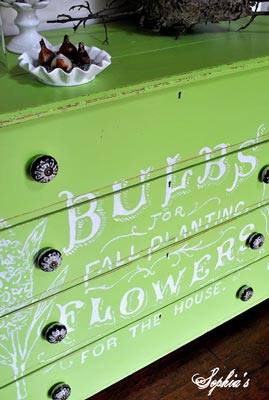 Finding and old piece of furniture–something that’s seen it’s better days–and breathing new life into it with a little paint and some creativity is easily one of my favorite do-it-yourself projects. I love it because it’s usually inexpensive (if you’re a smart shopper), doesn’t take much time, and the results can be dramatic.
Finding and old piece of furniture–something that’s seen it’s better days–and breathing new life into it with a little paint and some creativity is easily one of my favorite do-it-yourself projects. I love it because it’s usually inexpensive (if you’re a smart shopper), doesn’t take much time, and the results can be dramatic.
Today, I want to highlight and recommend a simple project we discovered on a great decorating blog called “Sophia’s Decor“. (Check it out sometime–you’ll thank us later!)
This is a simple project that anyone can accomplish. Please head to Sophia’s Decor for some great pictures and more detailed comments about the project. But to quickly summarize:
Here’s What You Need:
- A piece of furniture to paint (this is important)
- Paint (main color and stencil color)
- TSP
- Sandpaper
- Paint Supplies
- Stencil or Projector
Here’s What You Do:
 |
Start by scuff sanding your furniture piece with some 120-150 grit sandpaper. This doesn’t need to be a complicated, lengthy, arm-breaking, sweat-producing sanding job. You’re basically just dusting over the piece to dull the previous finish so your paint will bond. |
 |
After the scuff-sanding, wash the piece down with a TSP and water mixture. This will remove the sanding dust and will also help to clean away any surface contaminants that might be left from cleaners and so on. |
 |
When the piece is completely dry, apply your main color. Brush or roll it directly onto the furniture piece without a primer. (If you plan to distress it, it’s important to skip the primer step.) |
 |
Once the piece is painted (it may take one or two coats depending on your color), go ahead and distress it. This is a bit of an art project and takes a little bit of thought. It’s not complicated, but you want to be careful to create an authentic distressed look without going too far. Carefully run your sandpaper over the edges of the drawers and the top and the legs and you’ll notice that very quickly you cut through to the wood beneath. Work around the spots that would see normal wear over the years: the drawer pulls, edges and so on. Continue like this until you’ve achieved the look you desire and then wipe the piece clean with a damp rag. |
 |
When it’s dry, it’s time to apply the stencil. This part will take some planning and some thinking and some searching to find just the right graphic. In this case, the blogger at Sophia’s Decor used a projector to display the image on the dresser and then she traced it with a pencil, using an off white paint to fill in the lines. You could also accomplish the same affect if you found a stencil to your liking. |
 |
However you put the design on, let it dry a couple days. Once it’s dry, the last step is a light sanding over the letters. (Don’t work too hard with this sanding or you’ll remove too much of the lettering!) The goal here is to lightly distress the lettering and give the piece an aged look. |
 |
At that point, you can leave the piece as is, or, if you prefer, you could apply a light, single coat of polyurethane in a low-gloss or flat finish. A solvent-based polyurethane will yellow slightly over time, so be aware of that before you top-coat anything that’s white! |
Overall, this project will take you a couple days from start to finish–though most of that time will be just letting it dry in between paint coats. It’s fun, easy and, because the furniture piece is small compared to the room it is eventually placed in, you can experiment with colors that might be too strong for the walls.
If you try something like this, or have a project you think turned out really well, please post a pic on our Facebook page here. We love to see what you’ve come up with!


 Has this ever happened to you: you walk into the paint store for paint and then spend the next three days or a week or more agonizing over the color chips you brought home? You hold them up to every piece of furniture in the room. You lay them on your carpet, on your end table. You try to picture them large scale–covering your walls. You debate between one shade and a slightly darker shade. And then, finally, after all the debate and analysis and agony, you pick the perfect colors.
Has this ever happened to you: you walk into the paint store for paint and then spend the next three days or a week or more agonizing over the color chips you brought home? You hold them up to every piece of furniture in the room. You lay them on your carpet, on your end table. You try to picture them large scale–covering your walls. You debate between one shade and a slightly darker shade. And then, finally, after all the debate and analysis and agony, you pick the perfect colors. Most folks forget about their ceilings when it comes time to paint and as a result, most ceilings are forgettable.
Most folks forget about their ceilings when it comes time to paint and as a result, most ceilings are forgettable. However, there’s something very interesting to realize here: many folks understand this concept and they figure that painting those ceilings white will really serve to open the room up. However, think about this: if you’ve got a medium toned color on your walls, no matter what shade, a white on the ceiling can often produce a very sharp distinction between the walls and the ceiling. This sharp distinction, this high contrast between walls and ceiling, can often lead people to conclude that their wall color doesn’t work–that it needs to be repainted.
However, there’s something very interesting to realize here: many folks understand this concept and they figure that painting those ceilings white will really serve to open the room up. However, think about this: if you’ve got a medium toned color on your walls, no matter what shade, a white on the ceiling can often produce a very sharp distinction between the walls and the ceiling. This sharp distinction, this high contrast between walls and ceiling, can often lead people to conclude that their wall color doesn’t work–that it needs to be repainted. Imagine the same room with a white ceiling. In fact, you don’t have to imagine it, look at the picture below. That’s the same room with a standard white on the ceiling and the whole mood of the room changes. The stark white on the ceiling makes the green on the walls feel harsh. Many times, folks would paint a room like this, think they love that green, only to be back later for new paint because the color’s just too strong on the walls.
Imagine the same room with a white ceiling. In fact, you don’t have to imagine it, look at the picture below. That’s the same room with a standard white on the ceiling and the whole mood of the room changes. The stark white on the ceiling makes the green on the walls feel harsh. Many times, folks would paint a room like this, think they love that green, only to be back later for new paint because the color’s just too strong on the walls.
 I received a question in my email the other day regarding touching up some paint on a wall. The question was a good one and I thought I’d spell out a few simple tips here that will help make your next touch-up job go a little easier.
I received a question in my email the other day regarding touching up some paint on a wall. The question was a good one and I thought I’d spell out a few simple tips here that will help make your next touch-up job go a little easier.
 Once upon a time, probably about 6 years ago or so, my wife and I walked with our kids to the Zeeland Bakery. Caleb (who was 5 at the time) waited outside with me while my wife and the other kids sauntered into the shop and ordered various donuts and cookies and different types of bread. (It’s always a huge undertaking whenever we go to the bakery).
Once upon a time, probably about 6 years ago or so, my wife and I walked with our kids to the Zeeland Bakery. Caleb (who was 5 at the time) waited outside with me while my wife and the other kids sauntered into the shop and ordered various donuts and cookies and different types of bread. (It’s always a huge undertaking whenever we go to the bakery).
 Every now and then I hit upon something that I know is a good idea. And, though this doesn’t happen very often, this is one of those times. There’s no way around it: decorating your kids’ rooms with their help is a great opportunity for you and for them. Oh, I know there are lots of little bugs in the idea and potential complications–but that doesn’t change the fact that it’s a good thing to do.
Every now and then I hit upon something that I know is a good idea. And, though this doesn’t happen very often, this is one of those times. There’s no way around it: decorating your kids’ rooms with their help is a great opportunity for you and for them. Oh, I know there are lots of little bugs in the idea and potential complications–but that doesn’t change the fact that it’s a good thing to do.
 I’m a “dreader”. That’s not a word–I know that. But that doesn’t change the truth: I dread things. On a regular basis.
I’m a “dreader”. That’s not a word–I know that. But that doesn’t change the truth: I dread things. On a regular basis.